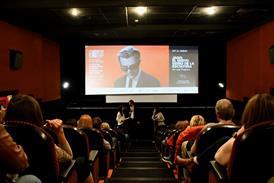Steve McQueen’s solemn tribute to Amsterdam is an ethereal visualisation of collective memory past and present

Dir. Steve McQueen. UK, The Netherlands, US. 2023. 262mins.
Every city has a history, and some older European conurbations have particularly bloody ones. Steve McQueen listens to the past and watches the lockdown-era present in a tribute to his adopted city of Amsterdam in Occupied City, a film designed to achieve a cumulative resonance. The details and deaths of Nazi-controlled streets during the occupation and the Hunger Winter of 1944 are spoken over the footage of an Amsterdam coping with Covid-19. Written and co-produced by McQueen’s partner Bianca Stigter, this is an extended – at 262 mins, plus a recommended 15-minute intermission – art project that never changes in its steady, solemn tone as the camera roves over buildings, or demolished spaces, that saw ghastly deeds committed in the name of the so-called master race.
After four hours, there’s no sense you know the city, present or past… Instead you are haunted by it
The camera is interested in everything, and the imagery can be disconnected: at times the visuals are acutely linked to the text being read, at others, the film wanders into playgrounds, parades or protests, and onto buses, as the seasons change. The sense of time is something McQueen seeks to emphasise: can we visualise collective memory while, as spectators in the room, we watch people walk the same streets that knew such terror, wondering if they feel it, if the ghosts are tangible to them, too? The film achieves its goal in this respect, although it is a singular commitment for viewers – much as the stories of the dead aren’t chronological, neither is the city mapped out in a way that’s accessible for those who aren’t familiar with it. Silence fills the room at the end credits, the words ‘murdered in Auschwitz’ ringing in our ears: never forget.
Picked up for world sales by A24 (the UK’s Film4 co-produced), Occupied City had its world premiere in Cannes and will now move into highly-specialised play. The type of person – a festival-goer, undoubtedly – who seeks this out will be certain to appreciate it and the beauty of the imagery presented in Academy Ratio; nobody will commit to it by accident. It may be compared to Shoah, but it’s a far more ethereal piece; no photographs of the past, or testimony or attempt at narrative, although the camera does end peering out the front of a tram in a beautiful tribute. There’s a sense that McQueen has grafted his film onto the city’s silent walls of witness, present or demolished. Much as the British artist and film-maker’s other work, whether for galleries, TV, or cinema, has been creatively influential, Occupied City is likely to follow suit.
Occupied City, although it speaks of facts that hit like blows, is a subtle piece of work. McQueen’s imagery shows children at play and old people being vaccinated, a multi-racial society, touchy about lockdown and any sense of central control, the reasons for which will become increasingly clear. They break the rules to flock to the street for King’s Day. They test and they dance. Time passes and imagery extends to include lengthy footage of a climate change protest and on to the arrival of the first Ukrainians in the city. Amsterdam with its arms wide open. But there’s a point where the camera, following tram lines through Amsterdam Station, swerves on its axis – the world turned upside down, then and now.
Meanwhile, the marvellously controlled voice of British actor Melanie Hyams delivers Stigters’ concise texts, drawn from her book ‘Atlas of an Occupied City (Amsterdam 1940-1945)’. How the Nazis melted down bicycles and church bells. How a strike during the occupation led to the Nazis opening fire on the protestors and murdering nine of them. How a 16-year-old boy was gunned to death for being out two minutes after curfew. How blackouts meant people fell in the canals and drowned. How many Jews, some of whom had already fled to the city from Germany, died by suicide rather than at the hands of the Nazis.
There was an enthusiastic Dutch Nazi Party and a devoted resistance. At the end of the occupation, 60,000 of the city’s 80,000 Jews were dead and those left from the City’s population of 800,000 were starving to death. The Dutch Government and Queen in exile in London had capitulated after Rotterdam was flattened by the Germans; Amsterdam survived, but only barely. Now the camera asks how it will go forward today.
McQueen’s unhurried pacing – editing by Xander Nijsten is deliberately set to his tone – can lead to a sense of frustration. Music by Oliver Coates, with the occasional burst of Bowie, Roxy Music and even Bob Marley, is to be savoured. After four hours, there’s no sense you know the city, present or past, or that you ever will understand it. Would maps and timelines make it any more ‘satisfying’? Instead, you are haunted by it. Stigter’s texts tell of things that can’t be forgotten, won’t be demolished, and take up space in every city, every street, while still being specific to the Holocaust itself, and a righteous testament to it.
Production companies: Family Affairs, Lammas Park
International sales: A24, international@a24films.com
Producers: Steve McQueen, Bianca Stigter, Floor Onrust, Anna Smith-Tenser
Screenplay: Texts written by Bianca Stigter
Cinematography: Lennert Hillege
Editing: Xander Nijsten
Music: Oliver Coates
Narration: Melanie Hyam







![The Brightest SunScreen[Courtesy HKIFF]](https://d1nslcd7m2225b.cloudfront.net/Pictures/274x183/3/5/0/1448350_thebrightestsunscreencourtesyhkiff_312678.jpg)















![The Brightest SunScreen[Courtesy HKIFF]](https://d1nslcd7m2225b.cloudfront.net/Pictures/100x67/3/5/0/1448350_thebrightestsunscreencourtesyhkiff_312678.jpg)
